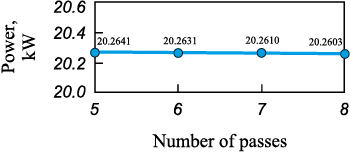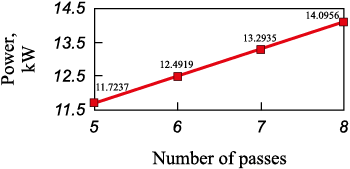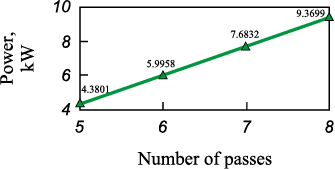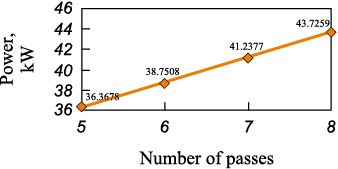Scroll to:
Energy consumption analysis of multistage steel wire drawing
https://doi.org/10.17073/0368-0797-2025-3-228-232
Abstract
The paper analyzes energy consumption during steel wire drawing for pass schedules with different number of passes. The authors compare wire drawing pass schedules that have different number of passes and the same total reduction. Dependences of the wire drawing process parameters on the number of passes were calculated. The methods for calculating the uniform and redundant deformation work, the friction forces work during wire drawing in monolithic dies are presented. The authors obtained the dependences of uniform and redundant deformation work, as well as the friction forces work and total work on the passes number of the pass schedule. A significant proportion of energy consumption is due to redundant work. Such wire drawing deformation measures as reduction and elongation do not consider redundant deformation. The redundant deformation work depends on the shape of the deformation zone characterized by the ∆-factor, which is equal to the ratio of the average height to the average length of the deformation zone. It was established that energy consumption calculations for wire drawing without taking into account redundant deformation lead to energy consumption underestimation. The paper provides criteria for selecting the number of passes, taking into account the energy consumption for wire deformation during wire drawing. It was determined that an increase in multistage wire drawing number of passes with the initial and final wire diameters equal leads to an increase in energy consumption for wire deformation and friction on the wire-die contact surface. The redundant deformation share in the increase in energy consumption for wire drawing was 68 %, the friction forces share was 32 %. The authors provide recommendations for choosing the optimal pass schedule based on the results obtained.
Keywords
For citations:
Goloviznin S.M., Bryukhanov I.Yu. Energy consumption analysis of multistage steel wire drawing. Izvestiya. Ferrous Metallurgy. 2025;68(3):228-232. https://doi.org/10.17073/0368-0797-2025-3-228-232
Introduction
One of the key factors that influence the quality of the finished product and the conditions of wire drawing is the choice of the pass schedule, i.e., the selection of the number of passes and the individual reductions of the drawing dies. The pass schedule must ensure the absence of wire breaks and guarantee the required quality of the finished product while maintaining maximum productivity [1 – 5].
When designing modes for multistage wire drawing, it is necessary to take into account factors such as lubrication conditions, wire heating, the mechanical properties of the wire, energy consumption, number of passes, and the values of total and individual reductions [2; 3; 6; 7]. The number of passes has a significant effect on the stability of the wire drawing process and the quality of the finished wire, which necessitates an analysis of pass schedules with different number of passes and their impact on the technological parameters of the steel wire drawing process [8 – 10].
The productivity of wire drawing mills is largely determined by the energy consumption for wire deformation [11; 12]. The energy consumption in wire drawing consists of the energy required to overcome friction between the wire and the drawing die, and the energy spent on wire deformation within the die [13 – 15]. The deformation work includes uniform work, associated with the change in wire diameter, and redundant work, caused by a change in the direction of metal flow at the entry and exit of the deformation zone [16]. The degree of deformation in wire drawing is usually assessed using values such as reduction and elongation, which do not account for the presence of redundant deformation, i.e., deformation not related to the change in wire diameter. Redundant deformation can be assessed using the redundancy factor (Ф), defined as the ratio of the redundant deformation share to the total deformation [1]. The presence of additional redundant deformation is often overlooked when developing pass schedules, which leads to an underestimation of deformation work in multistage drawing of wireи [17 – 21].
Materials and methods
The study examined the following pass schedules for steel wire drawing:
– a five-pass schedule: 9.00 – 7.79 – 6.85 – 6.10 – 5.50 – 5.03 mm;
– a six-pass schedule: 9.00 – 7.95 – 7.00 – 6.80 – 6.10 – 5.50 – 5.03 mm;
– a seven-pass schedule: 9.00 – 8.19 – 7.48 – 6.85 – 6.31 – 5.83 – 5.40 – 5.03 mm;
– an eight-pass schedule: 9.00 – 8.30 – 7.70 – 7.10 – 6.60 – 6.10 – 5.65 – 5.30 – 5.03 mm.
In all the analyzed pass schedules, the initial and final wire diameters – and therefore the total reduction – remain the same.
Redundant (additional) work was accounted for using the redundancy factor
\[\Phi = \frac{{{w_u} + {w_r}}}{{{w_u}}},\]
where wu is the uniform deformation work, and wr is the redundant deformation work.
Uniform deformation work is given by
| \[{w_u} = {\sigma _a}\ln \left( {\frac{1}{{1 - r}}} \right),\] | (1) |
where σa is the average flow stress during wire drawing, and r is the reduction.
Redundant deformation work
| \[{w_r} = (\Phi - 1){w_u} = (\Phi - 1){\sigma _a}\ln \left( {\frac{1}{{1 - r}}} \right).\] | (2) |
Total deformation work
| \[w = \Phi {\sigma _a}\ln \left( {\frac{1}{{1 - r}}} \right).\] | (3) |
Redundancy factor
| \[\Phi = 0.8 + \frac{\Delta }{{4.4}},\] | (4) |
where ∆ is the ∆-factor of the deformation zone during wire drawing, defined as the ratio of its average height to average length.
The average numerical value of Δ [1; 16] is determined as
| \[\Delta = \frac{\alpha }{r}{\left[ {1 + {{(1 - r)}^{1/2}}} \right]^2} \approx \frac{{4\tan \alpha }}{{\ln \left( {\frac{1}{{1 - r}}} \right)}},\] | (5) |
where α is the half-angle of the die cone.
The general expression for the friction forces work per unit volume is
| \[{w_f} = \mu {\rm{ctg}}\alpha \Phi {\sigma _a}\ln \left( {\frac{1}{{1 - r}}} \right),\] | (6) |
where µ is the friction coefficient.
The friction work in the bearing zone is typically neglected in practical calculations.
Results and discussion
Based on the performed calculations, the dependencies of friction work, uniform deformation work, and redundant deformation work on the number of passes in steel wire drawing were obtained for the pass schedules described above. It was assumed that the initial and final wire diameters, the friction coefficient, and the flow stress remained constant for all analyzed schedules. Fig. 1 shows the relationship between the total uniform deformation work and the number of passes in the wire drawing process.
Fig. 1. Total uniform work depending on the number of passes |
In this case, the total deformation work refers to the sum of the deformation work for all passes in the multistage drawing process. According to the obtained data, the total uniform deformation work does not depend on the number of passes in the pass schedule if the total reduction remains constant, since uniform deformation work is determined by the reduction and the flow stress of the wire [1].
As shown in Fig. 2, with an increase in the number of passes and constant initial and final wire diameters, the friction work increases. This can be explained by the fact that increasing the number of passes leads to a decrease in the average reduction, an increase in the ∆-factor and redundancy factor, and a greater number of passes. The increase in deformation power due to friction work when increasing the number of passes from five to eight amounted to 2.4 kW.
Fig. 2. Total friction forces work depending on the number of passes |
Fig. 3 presents the dependence of the total redundant deformation work, i.e., the sum of redundant work over all passes in the pass schedule, on the number of passes.
Fig. 3. Redundant deformation work depending on the number of passes |
According to the plot in Fig. 3, the total redundant deformation work increases with a higher number of passes. As the number of passes increases, the average reduction decreases, the ∆-factor increases, and, according to expression (4), the redundancy factor Φ also increases, which leads to an increase in redundant deformation work. Additionally, the increase in the number of passes contributes further to the growth of redundant work. The increase in deformation power caused by redundant deformation work when increasing the number of passes from five to eight amounted to 4.98 kW.
Fig. 4 shows the dependence of the total work, i.e., the sum of uniform deformation work, redundant deformation work, and friction work over all passes, on the number of passes in the wire drawing pass schedule.
Fig. 4. Total work depending on the number of passes |
According to the relationship shown in Fig. 4, energy consumption for wire drawing increases with a higher number of passes. The total rise in deformation power when increasing the number of passes from five to eight amounted to 7.37 kW. The primary contributors to this increase are the redundant deformation work and the friction work. The uniform deformation work is determined by the total deformation, that is, the initial and final wire diameters. Although the friction work per pass decreases with lower reduction and a constant friction coefficient, this decrease is compensated by the greater number of passes in the wire drawing schedule. As a result, the total friction work increases with the number of passes. The redundant deformation work is influenced by the shape of the deformation zone, specifically the value of the ∆-factor. As the number of passes increases, the ∆- factor also increases, leading to a further rise in redundant deformation work.
In [9], calculations were carried out and recommendations were proposed for selecting the optimal number of passes in the pass schedule for drawing 70-grade wire, taking into account various influencing factors. The conclusions presented in [9] are consistent with the findings of the present study. It was shown that reducing the number of passes from 10 to 9 improves deformation uniformity across the wire cross-section while also reducing energy consumption during wire drawing.
Conclusions
An increase in the number of passes at constant initial and final wire diameters leads to higher energy consumption during wire drawing. The rise in energy consumption is primarily due to the contributions of friction work and redundant deformation work. For the wire drawing schedules examined, the increase in deformation power associated with friction accounted for 32 %, while the share attributed to redundant deformation was 68 %. The increase in friction work is caused by a higher ∆-factor of the deformation zone, which results from reduced average reduction and a greater number of passes. Redundant deformation work contributes significantly to the rise in energy consumption as the pass count increases. Calculations that do not take redundant deformation into account lead to an underestimation of energy consumption in wire drawing. Since redundant deformation work is determined by the ∆-factor of the deformation zone, it must be considered when designing pass schedules for steel wire drawing. Uniform deformation work is governed by the initial and final wire diameters and does not contribute to the increase in energy consumption as the number of passes grows. To reduce energy costs during wire drawing, it is advisable to optimize the pass schedule by adjusting the number of passes and individual reductions, taking into account other technological parameters of the wire drawing process.
References
1. Wright R.N. Wire Technology: Process Engineering and Metallurgy. Butterworth-Heinemann; 2016:340.
2. Enghag P. Steel Wire Technology. 2nd ed. Örebro: Applied materials technology. Materialteknik HB; 2002:311.
3. Dieter G.E., Kuhn H.A., Semiatin S.L. Handbook of Workability and Process Design. Materials Park, Ohio: ASM International; 2003:409.
4. Belalov Kh.N., Klekovkin A.A., Klekovkina N.A., Gun G.S., Korchunov A.G., Polyakova M.A. Steel Wire: Monograph. Magnitogorsk: Nosov MSTU; 2011:395. (In Russ.).
5. Perlin I.L., Ermanok M.Z. Drawing Theory. Moscow: Metallurgiya; 1971:448. (In Russ.).
6. Lee S.-K., Lee S.-B., Kim B.-M. Process design of multi-stage wet wire drawing for improving the drawing speed for 0.72wt% C steel wire. Journal of Materials Processing Technology. 2010;210(5):776–783. https://doi.org/10.1016/j.jmatprotec.2010.01.007
7. Goloviznin S.M., Maminov G.I., Terskikh D.S., Goloviznin D.S. Influence of route multiplicity and drawing rate on microhardness distribution over steel wire cross section. Metallurgist. 2020;64(1-2):145–152. https://doi.org/10.1007/s11015-020-00976-z
8. Kharitonov V.A., Gallyamov D.E. Spring Wire Production. Magnitogorsk: Nosov MSTU; 2013:153. (In Russ.).
9. Maminov G.I., Goloviznin S.M., Terskikh D.S. Recommendations development for steel wire drawing number of passes. Modelirovanie i razvitie protsessov OMD. 2018;(26):39–44. (In Russ.).
10. Maminov G.I., Goloviznin S.M. The influence of pass schedule on the steel wire drawing conditions. Modelirovanie i razvitie protsessov OMD. 2018;(24):53–60. (In Russ.).
11. Zyuzin V.I., Klekovkina N.A., Kharitonov V.A., etc. Resource Saving in Hardware Production: Theory and Practice of the Beloretsk Metallurgical Plant. Collective Monograph. Magnitogorsk: Nosov MSTU; 2001:163. (In Russ.).
12. Radionova L.V., Lisovsky R.A., Lezin V.D. Theory of Energy Conservation as the Basis for the Design of Wire Drawing. In: Proceedings of the 6th Int. Conf. on Industrial Engineering (ICIE 2020). ICIE 2021. Radionov A.A., Gasiyarov V.R. eds. Springer, Cham;2021:1150–1163. https://doi.org/10.1007/978-3-030-54817-9_134
13. Kharitonov V.A., Goloviznin S.M. Design of High-Speed Wire Drawing Modes Based on Simulation: Monograph. Magnitogorsk: Nosov MSTU; 2011:117. (In Russ.).
14. Sas-Boca I.M., Tintelecan M., Pop M., Iluţiu-Varvara D.-A., Mihu A.M. The wire drawing process simulation and the optimization of geometry dies. Procedia Engineering. 2017;181: 187–192. https://doi.org/10.1016/j.proeng.2017.02.368
15. Suliga M., Wartacz R., Kostrzewa J., Hawryluk M. Assessment of the possibility of reducing energy consumption and environmental pollution in the steel wire manufacturing process. Materials. 2023;16(5):1940. https://doi.org/10.3390/ma16051940
16. Backofen W.A. Deformation Processing. Reading – Mass: Addison-Wesley; 1972:326.
17. Caddell R.M., Atkins A.G. The influence of redundant work when drawing rods through conical dies. Journal of Engineering for Industry. 1968;90(2):411–416. https://doi.org/10.1115/1.3604653
18. Hwang J.-K. Impact of die radius in a streamlined die during wire drawing. Applied Sciences. 2021;11(9):3922. https://doi.org/10.3390/app11093922
19. Kajino S., Tanai Y., Shioda M., Hasegawa Y., Kubota K. Improving accuracy of aluminum alloy wire drawing force prediction by examining friction and redundant work. Journal of Manufacturing Processes. 2024;124:1449–1458. https://doi.org/10.1016/j.jmapro.2024.06.061
20. Majzoobi G.H., Saniee F.F., Aghili A. An investigation into the effect of redundant shear deformation in bar drawing. Journal of Materials Processing Technology. 2008; 201(1-3):133–137. https://doi.org/10.1016/j.jmatprotec.2007.11.127
21. Park S.-C., Lee K.-H. Prediction method for shape drawing force considering redundant deformation. Journal of Advanced Marine Engineering and Technology. 2023;47(6):336–342. https://doi.org/10.5916/jamet.2023.47.6.336
About the Authors
S. M. GolovizninRussian Federation
Sergei M. Goloviznin, Cand. Sci. (Eng.), Assist. Prof. of the Chair “Metallurgy and Standardization”
38 Lenina Ave., Magnitogorsk, Chelyabinsk Region 455000, Russian Federation
I. Yu. Bryukhanov
Russian Federation
Il’ya Yu. Bryukhanov, Laboratory Assistant of the Chair “Metallurgy and Standardization”
38 Lenina Ave., Magnitogorsk, Chelyabinsk Region 455000, Russian Federation
Review
For citations:
Goloviznin S.M., Bryukhanov I.Yu. Energy consumption analysis of multistage steel wire drawing. Izvestiya. Ferrous Metallurgy. 2025;68(3):228-232. https://doi.org/10.17073/0368-0797-2025-3-228-232





































